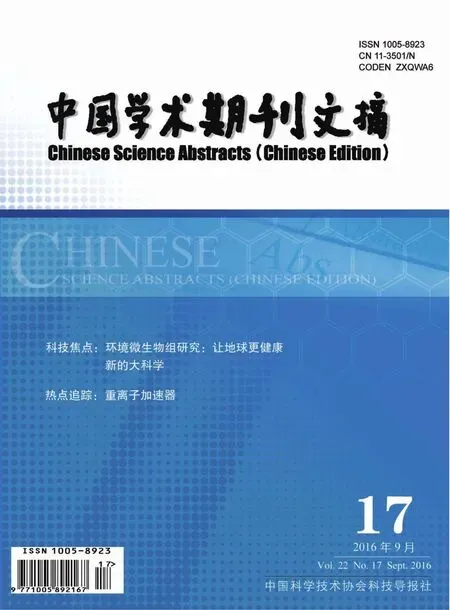重离子加速器
Influence of carbon material and sputtering angle on stripper foil lifetime
Sugai, I; Oyaizu, M; Takeda, Y; et al.
Laser ion-source for heavy-ion accelerators
Sharkov, BY; Shumshurov, AV; Dubenkow, VP; et al.
Experimental investigation of electron cooling and stacking of lead ions in a low energy accumulation ring
Bosser, J; Carli, C; Chanel, T; et al.
Verification of Monte Carlo transport codes FLUKA, GEANT4 and SHIELD for radiation protection purposes at relativistic heavy ion accelerators
Beskrovnaia, L; Florko, B; Paraipan, M; et al.
兰州重离子加速器研究装置HIRFL
夏佳文,詹文龙,魏宝文,原有进,赵红卫,杨建成,石健,盛丽娜,杨维青,冒立军
兰州重离子冷却储存环工程
夏佳文,詹文龙,魏宝文,等
重离子加速器
·编者按·
重离子加速器(Heavy Ion Accelerator)是指用来加速比α粒子重的离子加速器,有时也可用来加速质子。通过重离子加速器可以将大量的重离子加速到很高的速度,甚至接近光速,高速的重离子形成重离子束,用于开展重离子物理研究。重离子加速器还可用于:滴线核的研究、高温高密度条件下核物质性质研究、介子物理及粒子物理研究、高离化态原子物理研究、重离子束相关的应用研究。
兰州重离子加速器国家实验室是中国科学院负责建设和发展的国家实验室,拥有我国第1台大型重离子加速器系统。兰州重离子研究装置(Heavy Ion Research Facility in Lanzhou,HIRFL)是中国科学院近代物理研究所设计建造的我国能量最高的重离子物理研究装置,1988年12月建成出束。
近些年来,随着重离子加速器和探测技术等核科学技术的快速发展以及与其他学科交叉的不断拓展,特别是与生命科学技术的相互交叉,新现象和新效应不断地被揭示出来,产生了许多新的重大技术突破,如微米束及纳米束、重离子束深层治癌研究、高效定向育种和材料辐照等,为解决人类社会发展相关的健康、能源、农业、生态、环境、航天等重大问题提供了强有力的手段。
本专题得到王金川编审(中国科学院近代物理研究所)的大力支持。
·热点数据排行·
截至 2016年 8月 15日,中国知网(CNKI)和Web of Science(WOS)的数据报告显示,以“重离子加速器”为词条可以检索到的期刊文献分别为804条与684条,本专题将相关数据按照:研究机构发文数、作者发文数、期刊发文数、被引用频次进行排行,结果如下。
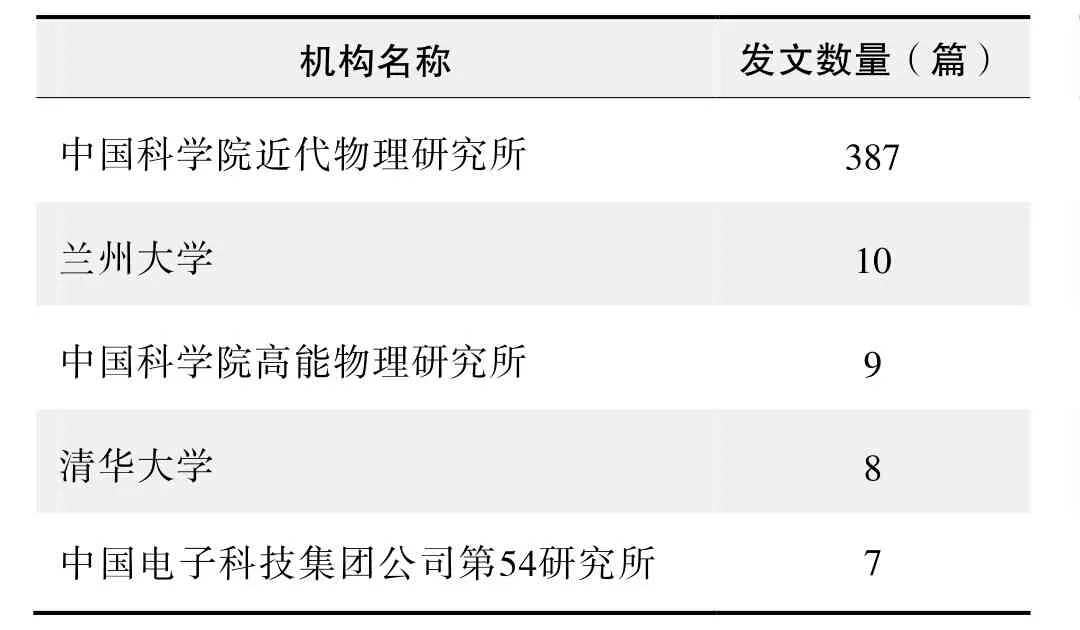
研究机构发文数量排名(CNKI)
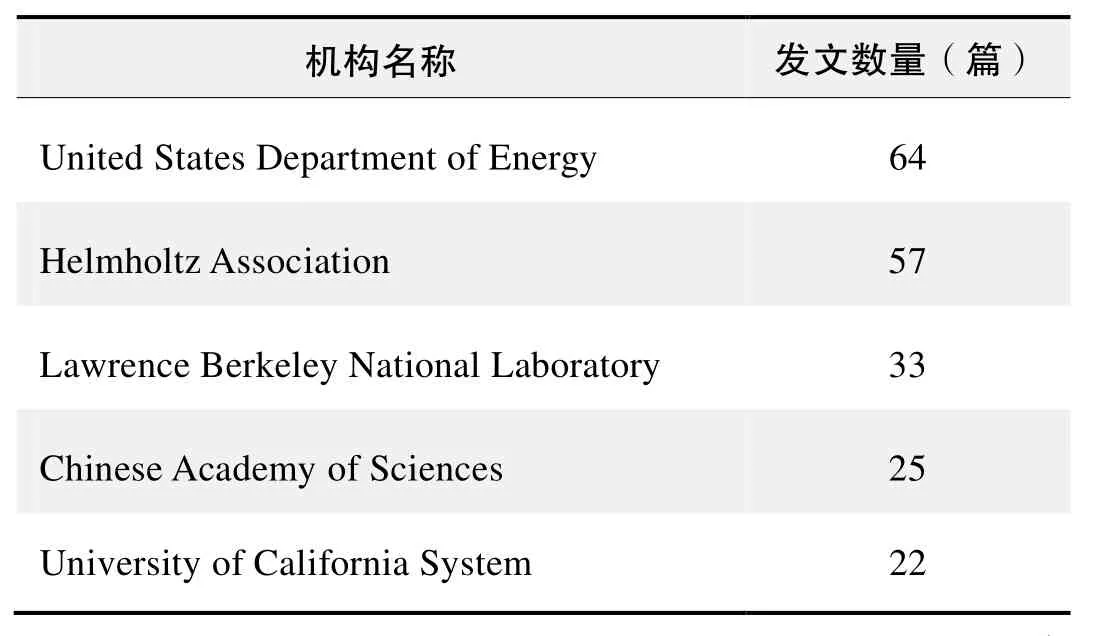
研究机构发文数量排名(WOS)

作者发文数量排名(CNKI)

?

作者发文数量排名(WOS)
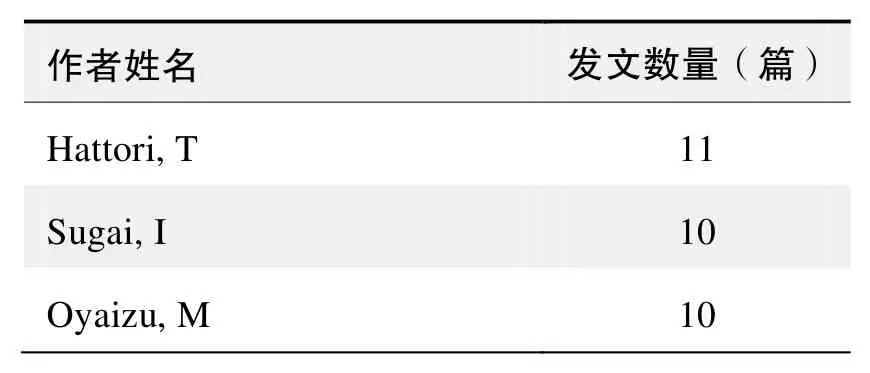
(数据来源:中国知网、Web of Science,检索时间:2016-08-15)
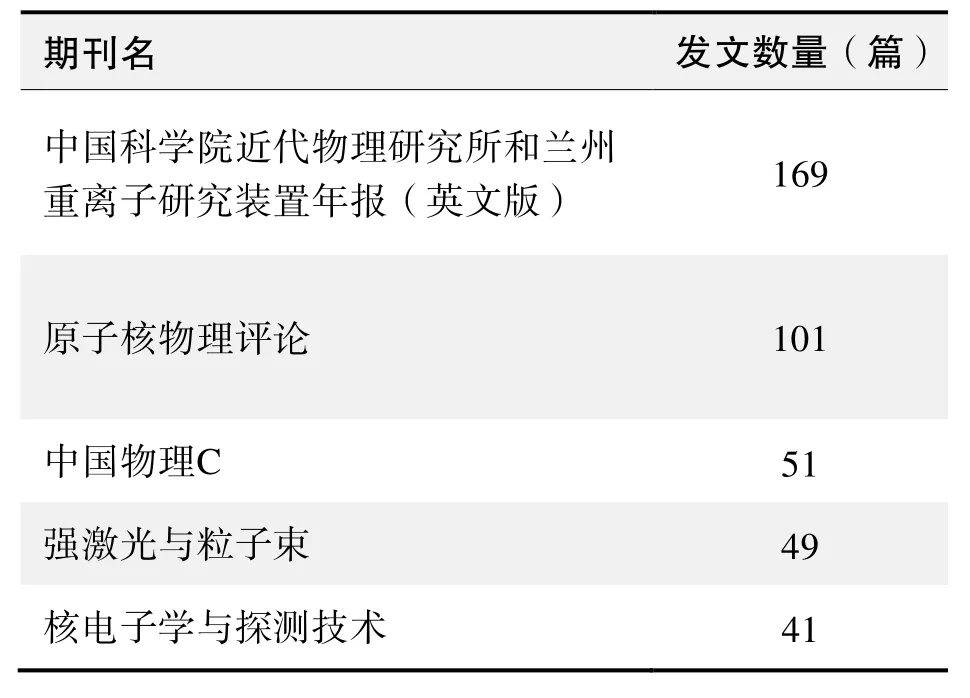
期刊发文数量排名(CNKI)
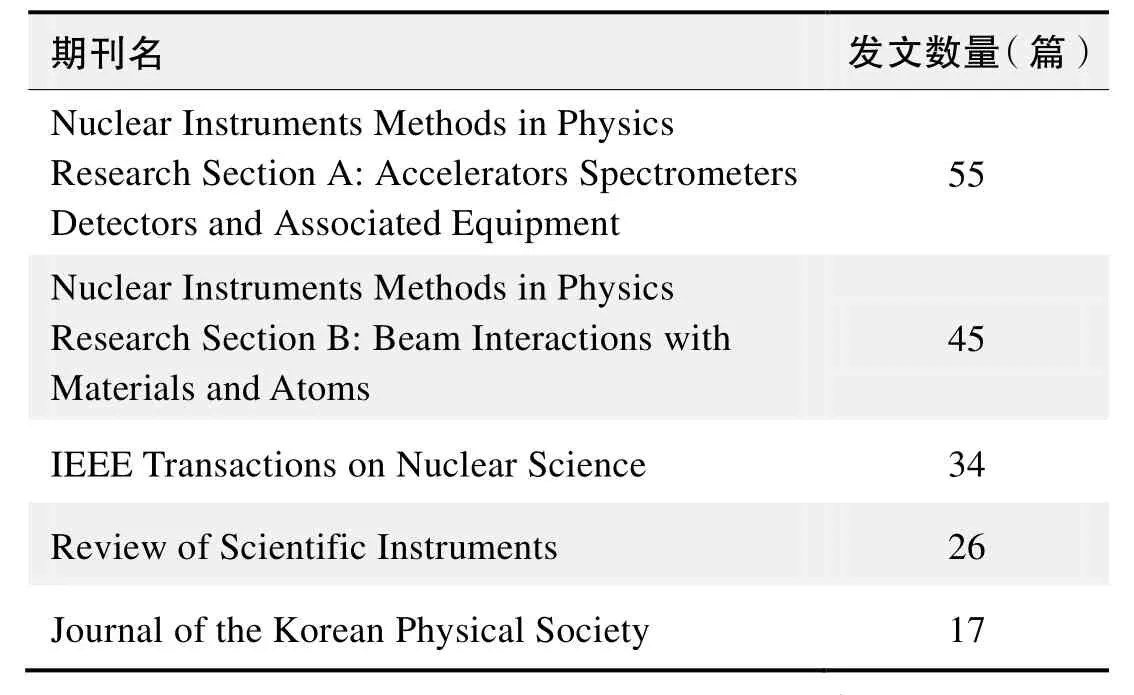
期刊发文数量排名(WOS)
根据中国知网(CNKI)数据报告,以“重离子加速器”为词条可以检索到的高被引论文排行结果如下。

国内数据库高被引论文排行
根据Web of Science统计数据,以“重离子加速器”为词条可以检索到的高被引论文排行结果如下。
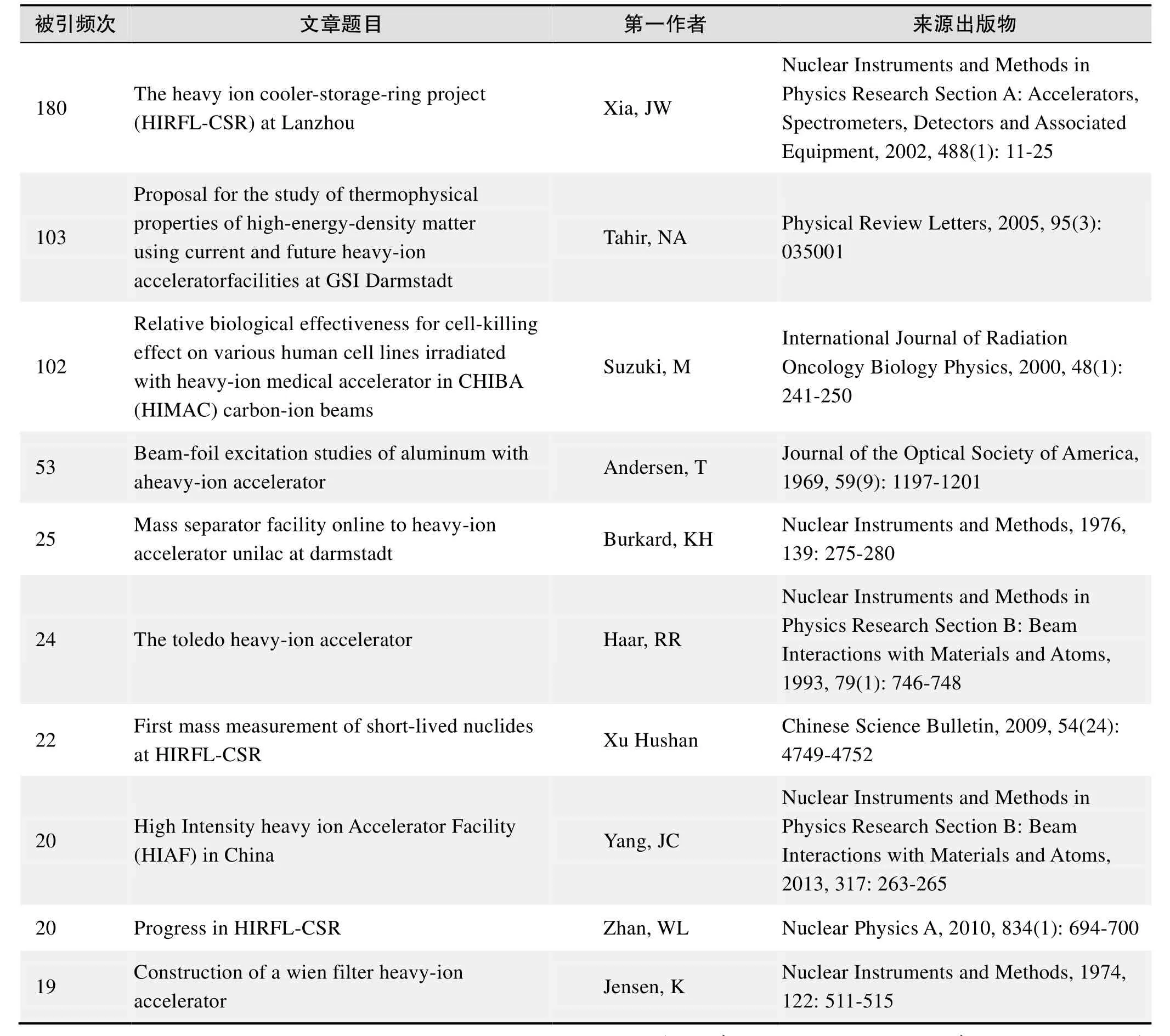
国外数据库高被引论文排行
·经典文献推荐·
基于Web of Science检索结果,利用Histcite软件选取LCS(Local Citation Score,本地引用次数)TOP 50文献作为节点进行分析,得到本领域推荐的经典文献如下。
来源出版物:Nuclear Instruments and Methods, 1971, 97(1): 1-17
Influence of carbon material and sputtering angle on stripper foil lifetime
Sugai, I; Oyaizu, M; Takeda, Y; et al.
Abstract:Mixed noble gas (Kr+Ne) was used for ion beam sputtering (MIBS) with the aim to produce stripper foils with long lifetime. Further characteristics of the MIBS method were investigated. Angular thickness distributions were measured for the deposits of three crystalline structures of carbon sputter targets: Synthetic diamond, glassy carbon and polycrystalline graphite. In this setup the vertical ion beam hits the horizontal surface of the respective carbon target. Differences are presented for three ion energies. In a second setup the angle of the sputter target relative to the vertical ion beam could be adjusted for preparing carbon deposits with lifetime dependences on the inclination angle alpha on a glassy carbon surface. Resulting stripper foils were tested for their lifetime depending on sputter material and sputtering angle 0 in case of graphite. The lifetime measurements were performed with a 3.2 MeV Ne+ion beam as usual.
carbon stripper; sputtering; stripper lifetime; heavy ion accelerator
来源出版物:Nuclear Instruments and Methods in Physics Research Section A: Accelerators, Spectrometers, Detectors and Associated Equipment, 2010, 613(3): 448-452
Laser ion-source for heavy-ion accelerators
Sharkov, BY; Shumshurov, AV; Dubenkow, VP; et al.
Abstract: The development, construction, and operation of laser ion sources for different types of heavy ion accelerators at ITEP are presented. A number of general physical problems connected with the special plasma heating regime by means of a powerful CO2laser were under consideration. The results of experimental measurements show that the currents up to congruent-to 103mA per pulses about 5-15μs and emittance less-than-or-equal-to 3 π-cm mrad have been achieved formulticharged ions of a large number of elements. The recent results of laser ion source operation on the ITEP Van-de-Graaf facility and on the 2 MV heavy ion synchrotron injector are reported.
来源出版物:Review of Scientific Instruments, 1992, 63(4): 2841-2843
Experimental investigation of electron cooling and stacking of lead ions in a low energy accumulation ring
Bosser, J; Carli, C; Chanel, T; et al.
Abstract: This report gives the results of a programme of experimental investigations, which were carried out to test stacking of lead ions in a storage ring (the former Low Energy Antiproton Ring, LEAR) at 4.2 MeV per nucleon, The motivation was to demonstrate the feasibility of gaining the large factor in the phase-space density required for injection into the Large Hadron Collider (LHC). In the first part of the report, the layout of the experiments is described, the choice of the parameters of the electron cooling system used for stacking is reported and the multiturn injection using horizontal-and longitudinal- (and in the final project also vertical-) phase space is discussed. In the second part the experimental results are presented. Factors of vital importance are the stacking efficiency, the beam life-time and the cooling time of the ions. The beam decay owing to charge exchange with the residual gas and to recombination by the capture of cooling electrons was intensively studied. Beam instabilities and space-charge effects in the ion beam turned out to be additional, although less serious, limitations of the accumulation rare. The cooling speed as a function of cooler and storage-ring properties was investigated over a wide range of parameters. Among the ‘surprises’ encountered are an anomalously fast recombination rate for certain ion charge states (Pb53+), a strong dependence of the cooling time on the dispersion function of the storage ring, and an intensity-dependent outgassing of equipment in the vacuum chamber. After a careful choice of parameters and antidotes, an overall factor of 120 in intensity could be gained, by multi-turn injection and stacking for 4 s. The intensity obtained (6 × 108ions with a length corresponding to four LHC bunches) is only a factor of two short of the LHC requirement. and the stacking time (4 s instead of 2 s foreseen for filling each LHC ring in 8 min) is another factor of 2 off.
来源出版物:Particle Accelerators, 1999, 63 (3): 171-210
Verification of Monte Carlo transport codes FLUKA, GEANT4 and SHIELD for radiation protection purposes at relativistic heavy ion accelerators
Beskrovnaia, L; Florko, B; Paraipan, M; et al.
Abstract:The crucial problem for radiation shielding design at heavy ion accelerator facilities with beam energies of several GeV/n is the source term problem. Experimental data on double differential neuron yields from thick targets irradiated with high-energy uranium nuclei are lacking. At present there are not many Monte Carlo multipurpose codes that can work with primary highenergy uranium nuclei. These codes use different physical models for simulating nucleus-nucleus reactions. Therefore verification of the codes with available experimental data is very important for selection of the most reliable code for practical tasks. This paper presents comparisons of the FLUKA, GEANT4 and SHIELD code simulations with experimental data on neutron production at 1 GeV/n U-238 beam interaction with a thick Fe target.
关键词:shielding data; relativistic heavy ions; thick target; neutron yield; monte carlo; code verification
来源出版物:Nuclear Instruments and Methods in Physics Research Section B: Beam Interactions with Materials and Atoms, 2008, 266(18): 4058-4060
·推荐综述·
兰州重离子加速器研究装置HIRFL
夏佳文,詹文龙,魏宝文,原有进,赵红卫,杨建成,石健,盛丽娜,杨维青,冒立军
重离子加速器具有重要的科学作用和社会意义,是研究物质微观结构、宇宙演化、解决人类有关生存环境问题的有效手段,如探索原子核存在的极限,探究宇宙中铁到铀元素的来源以及能量的起源,探究太阳系的演化过程等。此外,重离子加速器可为应用研究提供独特的实验条件,可开展高能量密度物理研究、先进能源相关材料研究、离子径迹与纳米技术研究、生命科学研究、高效生物农业研究、辐照相变与特殊功能材料研究、空间辐照效应研究以及信息材料技术研究等。重离子加速器一般采用直线加速器或者回旋加速器作为注入器,采用同步加速器或者回旋加速器做为主加速器将粒子加速到高能量,最后注入到储存环并开展内靶和外靶实验研究。
1国内外重离子加速器装置现状
目前,国际上运行和建设中的大型重离子加速器约30余台,而我国现有北京BRIF和兰州HIRFL以及即将建设的强流重离子装置 HIAF。国际上的重离子加速器主要有美国BNL-RHIC、日本RIKEN-RIBF,以及正在建设中的德国 FAIR、美国 MSU-FRIB、法国GANIL-SPIRAL2,国内外几台典型装置的发展状况如下。
北京原子能科学研究院的 HI-13串列加速器 1987年正式投入运行,2001—2002年进行了更新改造,加速器最高头部电压由13 MV提高到15 MV。北京放射性束装置(BRIF)是HI-13的升级工程,是在HI-13串列加速器的前端新建一台紧凑型等时性强流质子回旋加速器(100 MeV,200 μA),一台质量分辨率为20000的在线同位素分离器,以及在其后端新建一台具有2 MeV/q加速能力的超导重离子直线增能器,与现有的HI-13串列加速器组成一套加速器组合装置(中国原子能科学研究院网址:www.ciae.ac.cn)。目前,100 MeV的质子回旋加速器已经建成出束。该加速器组合装置有多种运行模式,回旋加速器单独使用时主要用于中子物理、辐射物理、生物医学的研究以及同位素研发;联合使用时,回旋加速器的质子束将用于轰击靶源,产生放射性同位素,经在线同位素分离器后注入串列加速器加速,为用户提供放射性核素束流。该加速器在亚库仑位垒熔合、原子核高自旋态结构、核天体物理、核数据测量、加速器质谱等方面取得了重要成果。
美国布鲁克海文国家实验室的相对论重离子对撞机(BNL-RHIC)于2000年开始运行,是目前世界上唯一的自旋极化质子对撞机(美国布鲁克海文国家实验室网址:www.bnl.gov/world/)。科学家利用 RHIC研究重离子/质子对撞产生的夸克—胶子等离子体的复杂过程,研究宇宙大爆炸后的早期现象。RHIC储存环为6边形结构,周长为3834 m,有6个对撞点。电子束离子源EBIS引出的重离子束首先经过 Tandems预加速,然后注入到增强器 Booster中加速,再注入到同步加速器AGS加速到高能量,最后经过高能传输线注入到RHIC,加速到相对论速度后开始碰撞。此外,质子—质子碰撞则采用直线加速器LINAC作为注入器,经过Booster,AGS后注入到RHIC。
日本理化学研究所 RIKEN的重离子加速器系统分两大部分:原有的加速器研究装置RARF,以及升级后的放射性同位素束流工厂RIBF(日本理化学所网站:www.riken.jp/)。RARF由重离子直线加速器RLAC,回旋加速器AVF以及回旋加速器RRC组成,其中RLAC和AVF都可作为RRC的注入器。AVF的能量常数为K=65;RRC的能量常数K=540,主要用于核物理和生物实验。随着科学家对更高能量的需求,RIKEN在RARF的基础上新建了3台回旋加速器:固定频率回旋加速器fRC、中间段回旋加速器IRC以及超导回旋加速器SRC,其能量常数K分别为570,980以及2500。2006年RIBF完成升级任务,共有5台回旋加速器,可级联加速,能将轻离子能量加速到440 MeV/u,铀离子能量加速到350 MeV/u。利用强流放射性束流可深入研究远离稳定线核素(奇异核)的结构、性质和反应,包括建立原子核新的统一图像,揭示元素的起源。此外,RIBF的成果还广泛应用于医疗、环境、农业、工业和考古等诸多领域。
德国重离子研究中心GSI的重离子加速器系统由离子源、直线加速器UNILAC、同步加速器SIS18、碎片分离器FRS、实验储存环ESR及若干束运线和实验终端组成。FRS可将打靶产生的放射性次级束进行高效的分离选择;ESR环内可开展原子核质量高精度测量以及内靶实验等研究。
FAIR是在德国GSI现有UNILAC,SIS18和ESR加速器基础上,新建同步加速器SIS100和SIS300、收集环CR、累积环RESR、储存环NESR、超级碎片分离器 SuperFRS、质子直线加速器 p-Linac和高能储存环HESR(德国重离子研究装置 GSI:www.gsi.de/start/ aktuelles.htm)。238U28+束流最高能量可达9.7 GeV/u、流强5×1011离子数/脉冲;质子束最高能量29 GeV/u、流强4×1013离子数/脉冲。FAIR由德国、法国和俄罗斯等10余个国家投资建造,已于2011年开工建设,预计2019年完成SIS100,RESR,HESR,FLAIR和p-Linac建造,2023年完成SIS300和实验探测装置建造。FAIR能够提供重离子和反质子束流,主要开展强子结构、远离稳定线原子核结构、强相互作用物质性质和重离子束应用等研究。
美国密歇根州立大学MSU国家超导回旋加速器实验室 NSCL由美国能源部资助(美国密歇根州立大学MSU:http://admissions.msu.edu/),主要从事稀有同位素和核物理研究,其在核结构、核天体物理、重离子反应机制、加速器物理、束流动力学以及实验技术和癌症治疗等方面都取得了许多成果。2009年美国能源部与MSU签署协议,在NSCL基础上建立新的超导重离子直线加速器、散裂靶、碎片分离器、气体阻止器以及次级束后加速器等,构成高流强的放射性稀有同位素装置 FRIB。FRIB的设计功率为 400 kW,质子束能量610 MeV、流强656 pμA;86Kr束流能量265 MeV/u、流强18.0 pμA;238U束流能量210 MeV/u、流强8.0 pμA。目前,FRIB已基本完成了直线加速器的模型腔、高频加速腔、靶分离装置、电荷剥离器等的预研和测试,计划于2022年完成工程建设。FRIB主要用于开展原子核结构、核天体物理、基本对称性检验和重离子束应用等研究。
法国重离子加速器国家实验室GANIL有2个放射性束装置SPIRAL1以及其升级装置SPIRAL2(法国重离子加速器国家实验室GANIL:www.ganil-spiral2.eu/)。SPIRAL1包括靶—源系统以及中能回旋加速器系统,主要用于产生和加速放射性奇异核,该装置可产生质量数达90的轻奇异核,并将其加速到1/4光速。为了获得更高流强更高稳定性的放射性次级束,在原有加速器装置基础上新建了ISOL型放射性束流装置SPIRAL2。驱动器为超导直线加速器,设计氘束能量为1.5~40.0 MeV,流强5.0 mA;M/Q=3的重离子束能量2.0~14.5 MeV/u,流强1.0 mA。后加速系统是一台回旋加速器,能够提供能量为3~10 MeV/u的放射性束流。SPIRAL2于2013年完成了基础设施建设和加速器相关设备的设计、加工、测试和验收,于 2014年底开始调试。主要开展奇异原子核结构、核物质性质、基本对称性和离子束应用等研究。
2兰州重离子加速器研究装置HIRFL及先进强流重离子装置HIAF
兰州重离子加速器装置 HIRFL主要包括前级回旋加速器系统,如电子回旋共振ECR离子源、扇聚焦回旋加速器SFC、分离扇回旋加速器SSC,以及后加速冷却储存环CSR系统,如主环CSRm、实验环CSRe、连接两环之间的放射性束流分离线RIBLL2以及若干束运线和实验终端。HIRFL的2个回旋加速器SFC和SSC作为CSR的注入器,提供的离子束被CSRm累积、冷却并加速到更高能量,然后快引出打靶产生放射性次级束或高电荷态离子束。次级束流注入到 CSRe,在电子冷却辅助下储存或减速以开展多种内靶实验或者高精度的原子核质量测量实验。另一方面,束流可由CSRm慢引出开展癌症治疗临床实验以及单粒子效应研究等,也可以快/慢引出开展各种外靶实验。
2.1电子回旋共振ECR离子源
根据国际重离子加速器发展前沿,从1989年开始,中国科学院近代物理研究所从法国引进 CAPRICE型ECR(electron cyclotron resonance)离子源。经过两年的调试和改进,于1992年正式将这台10 GHz离子源在HIRFL上投入使用,这也是国际上第一次将CAPRICE型ECR源在回旋加速器上使用,明显提高了SFC引出束流强度。为配合ECR离子源的使用,对SFC进行了相应改造,其注入系统由原先使用PIG离子源时的水平方向内注入改为垂直方向外注入。1990年开始自行设计建造我国第一台10 GHz ECR离子源(ECR1)并于1993年投入使用。1997年又设计建造了一台14.5 GHz的ECR离子源(ECR2),于1999年投入使用。通过这些研究,发展了ECR离子源技术,积累了丰富的研制经验。
为了进一步提高 HIRFL加速极重离子的束流强度,2000年中国科学院批准中国科学院近代物理研究所研制超导高电荷态ECR离子源。作为中国科学院创新工程重大项目之一,经过近5年的努力,于2005年建成了在磁场设计和结构方面都有所创新的超导 ECR离子源,2006年通过了中国科学院组织的国内外专家进行的测试、鉴定和验收,并投入使用。
2.2扇聚焦回旋加速器SFC
扇聚焦回旋加速器SFC(Sector Focused Cyclotron)是一台螺旋扇聚焦的等时性回旋加速器,是中国科学院近代物理研究所由原有的 1.5 m直径的经典轻离子回旋加速器改造而成的,其能量常数为K=69。该加速器是“一五”时期前苏联援建我国的156个重大项目之一,由第二机械工业部投资和领导,于 1962年底安装就绪并开始调试,于1964年5月份正式投入运行。为配合“双超”(超钚、超重元素的合成)工作的开展,1970年中国科学院近代物理研究所将1.5 m回旋加速器成功地改装为我国第一台重离子加速器,目前可加速从氢到铀的所有离子。
SFC主体由圆形电磁铁、双层结构真空室和高频加速腔组成,可将H~U的重离子分别加速到10.0~1.28 MeV/u的能量,相应的引出流强为15~1 eμA。SFC作为HIRFL的注入器,在日常的科学研究中发挥了举足轻重的作用:一方面,SFC可以为SSC提供各种束流,进而在各种低能实验终端上开展多种物理研究以及相关学科的应用研究,如浅层治癌,材料辐照等;另一方面,从SFC引出的束流通过直通线直接注入到CSRm,进行后加速,以进行更高能量的实验。
2.3分离扇回旋加速器SSC
分离扇等时性回旋加速器 SSC(Separated Sector Cyclotron)是HIRFL系统中的主回旋加速器,其能量常数K=450,1988年建成出束,按建成顺序是国际现有8台中能重离子加速器中的第4台,是我国“七五”时期自主建设的重离子回旋加速器,碳离子束能量可达100 MeV/u。其主体由4台总重2000 t的扇形电磁铁、两台大型高频加速腔和100 m3真空室组成,轮廓直径12 m、高度6 m。SSC与SFC联合运行,可把典型的C~Bi的重离子分别加速到100~9.5 MeV/u的能量,相应的引出流强为3.5~0.1 eμA。SSC主要用于开展新核素合成和研究、中低能重离子碰撞和热核性质研究,以及重离子束应用研究等。
2.4冷却储存环CSR
兰州重离子加速器冷却储存环(HIRFL)是国家“九五”重大科学工程之一,2007年建成并投入运行,2008年7月通过国家验收,是国际上继德国GSI的SIS18-ESR之后又一个大型重离子冷却储存环装置。CSR由主环CSRm、实验环CSRe、放射性次级束分离线(RIBLL2)、实验探测装置等组成,是一个集累积、冷却、加速、储存、内靶实验及高分辨质量测量于一体的大型多功能实验装置,可提供C~U、单核子能量达GeV量级的重离子束,CSR主环加速的12C6+,36Ar18+束流的最高能量均达到了1000 MeV/u,流强分别为1190 μA(7.5×108ppp)和1200 μA(2.6×108ppp),技术指标达到国际先进水平。
HIRFL的创新发展,使我国重离子加速器技术水平及重离子物理实验研究能力进入世界前列,是我国放射性束核物理、极端条件下核物质性质研究、高离化态原子物理、核天体物理等基础研究领域的最大实验设施,是国内目前 LET航天器件单粒子效应检测以及辐射加固等国防任务最高的研究平台,为生命科学(如重离子深层治癌)、生物科学、材料与能源科学等应用研究提供了有力的支撑条件。
HIRFL在多个方面实现了技术创新和突破,使我国在重离子加速器领域实现了跨越式发展,推动了我国相关高新技术的发展及科技创新,带动了粒子加速器行业经济及西部区域的科技进步:(1)通过对重离子冷却储存环技术的创新发展,HIRFL突破了以回旋加速器作注入器时注入流强低的瓶颈,实现了重离子双冷却储存环与同步加速器高效组合,完成了从低能加速器向高能加速器的跨越。(2)创建了独特的非对称等时性磁聚焦结构,发明时间—幅度二维离子鉴别及相对时间数据修正的数据处理方法,使CSR在高精度直接测量短寿命近质子滴线核素领域取得重大突破,在世界上率先达到了10-7量级的相对测量精度,并在Z=23~35区的滴线核素质量测量处于国际领先地位,成为世界上原子核质量精确测量的最重要实验室之一。国际核质量评估系统已经转移至中国科学院近代物理研究所以进行核质量数据的权威发布,实现了我国在该领域的国际主导权。(3)通过综合集成创新,实现了重离子冷却储存环与同步加速器技术的整体突破。推动了我国高精度磁铁、大功率电源、超高真空系统等14个集成系统的相关领域高、精、尖工业技术水平的高速发展。(4)国际上首次采用回旋与同步加速器的组合模式,成功实现了重离子束深层治癌。目前已完成临床试验治疗,取得显著疗效,并开发了具有全部自主知识产权的专用重离子治疗装置,已被国家列为大力发展的特色优势产业,以及推进产业结构优化升级的“战略性新兴产业”。
2.5放射性次级束分离线
HIRFL的放射性次级束分离线有 RIBLL1和RIBLL2.RIBLL1全长35 m,由放射性束的产生、分离、鉴别和聚焦系统组成,1997年建成。它的设计集中了国际上已有4条中能重离子放射性束流线的优点,首次采用两段反对称双消色差传输结构,提高了对放射性束的分辨能力,质量分辨(A/△A)大于 200,动量接受度10%,最大磁刚度4.2 Tm。在RIBLL1上开展的物理研究,发现了一批具有质子晕、中子晕结构的奇异核素。
RIBLL2全长55 m,是中高能放射性次级束分离线,由反对称的双消色差传输结构组成,包含4台二极磁铁、20台四极磁铁、8台六极磁铁以及4台八极磁铁。CSRm提供的高品质中高能初级束打靶后,经RIBLL2分离出弹核碎裂等反应中产生的前冲碎片,注入到CSRe进行内靶实验;RIBLL2的第2部分也可用作谱仪分析次级束再打靶的产物,然后注入到CSRe;或者RIBLL2直接将次级束提供给终端,进行外靶实验。RIBLL2的质量分辨(A/△A)大于1200,动量接受度10%,最大磁刚度10.6 Tm。
2.6先进强流重离子加速器装置HIAF
即将建设的“十二五”国家重大科技基础设施—先进强流重离子加速器装置(High Intensity Heavyion Accelerator Facility,HIAF)由加速器系统和实验测量装置构成。加速器系统采用超导直线加速器、同步加速器和储存环组合的技术路线,主要包括:强流超导离子源 SECR、超导离子直线加速器 iLinac、磁刚度分别为34和43 Tm的增强器BRing和压缩环CRing、磁刚度为13 Tm的高精度环形谱仪SRing、能量回收型电子加速器ERL,以及相关配套设施。
利用离子源产生从氢到铀的强流离子束,注入iLinac进行预加速。iLinac是BRing的注入器,也可为低能物理实验提供强流离子束。BRing利用相空间涂抹和束流冷却技术将离子束累积到高流强并加速到高能量,引出束流注入到CRing或打靶产生放射性核素。放射性束流线分离和选择目标核并注入 SRing。在等时性工作模式下,SRing精确测量短寿命原子核的质量;在收集工作模式下,SRing制备高品质放射性束流,既可开展内靶实验也可引出束流注入到CRing或开展外靶实验。CRing采用束流纵向堆积和冷却技术储存尽可能多的离子并具有加速功能,在环内开展高电荷态离子的精细双电子复合实验;将束流压缩为百纳秒束团后快引出开展高能量密度物质性质研究,或超长周期慢引出束流进行辐照效应研究。ERL电子加速器提供的高品质电子束既可开展电子-原子核对撞研究,也可诊断高密度物质状态。HIAF的设计充分考虑了将来升级的空间和能力,BRing和CRing可升级为8字型结构加速器,产生高能极化质子束,结合后续建造的高能电子加速器,开展高亮度、双极化电子—质子对撞实验,研究核子的基本性质。
2.7主要研究成果
中国科学院近代物理研究所创建于1957年,是在周恩来总理提出建立的中国科学院兰州物理研究室基础上发展起来的。经过逾半个世纪的发展,近代物理研究所已成为在国际上有重要影响的重离子科学综合研究中心,是一个依托大科学装置,主要从事核物理基础前沿和重离子束应用研究、同时发展先进粒子加速器及核应用技术的研究所。主要研究方向有:原子核物理、原子与分子物理、高能量密度物理、材料科学、生命科学、ADS嬗变系统、先进粒子加速器等。
中国科学院近代物理研究所通过几代人的不懈努力和 3项大科学工程建设,建成了兰州重离子加速器(HIRFL)国家重大科技基础设施,主要技术指标达到国际先进水平,为我国重离子物理及交叉学科研究创造了先进的实验条件,取得了以新核素合成、原子核质量精确测量、重离子治癌为代表的一批重要科研成果,使我国进入重离子物理及交叉学科研究的国际先进行列。同时,在核技术产业化方面也取得了重要进展,为我国科技、经济、社会的发展和国家安全作出了贡献。
中国科学院近代物理研究所共取得科研成果660多项,其中获国家奖17项、省部级奖158项。获得的主要科技奖项有:兰州重离子研究装置,获得 1992年国家科技进步一等奖;重质量丰中子新核素的合成、鉴别和研究,获得 1999年国家自然科学二等奖;中重缺中子区近滴线新核素合成及核结构实验研究,获得 2007年国家自然科学二等奖;超导高电荷态ECR离子源,获得 2008年国家科技进步二等奖;兰州重离子加速器冷却储存环工程,获得 2009年度中国科学院杰出成就奖和2012年国家科技进步二等奖。研究成果8次入选全国十大科技成就、科技新闻、科技进展和全国基础研究十大新闻。“新核素合成研究”入选“创新中国”的 60项科学成就。
3结论
重离子加速器在核物理、原子物理、天体核物理等研究领域具有重要的科学意义;在核探测、辐射医学以及医学物理等应用领域具有重大的社会需求;在核物理、核技术、辐射生物学、材料、生物与农业等交叉学科领域具有重要的应用前景。重离子加速器为促进人类发展和社会进步做出了巨大贡献。♦
【作者单位:1. 中国科学院近代物理研究所;2. 兰州重离子加速器国家实验室】
(摘自《科学通报》2016年第4/5期)
·高被引论文摘要·
被引频次:33
兰州重离子冷却储存环工程
夏佳文,詹文龙,魏宝文,等
兰州重离子加速器冷却储存环是兰州重离子研究装置的后续工程。它的建造目的是将重离子束的能量提高到 1 GeV/u附近,同时利用储存环电子冷却技术将束流品质提高一个数量级,并提供更多种类的重离子束,以开展更广范围和更高精度的物理实验。兰州重离子加速器冷却储存环是一个双储存环系统,由一个主环和一个实验环构成。对其总体布局、总体参数、主要功能进行了介绍。
关键词:重离子加速器;储存环;电子冷却
来源出版物:原子核物理评论, 2001, 18(1): 35-38
被引频次:30
兰州重离子加速器冷却储存环
夏佳文,詹文龙,魏宝文,等
摘要:兰州重离子加速器冷却储存环HIRFL-CSR,是一个多用途、多功能的双冷却储存环同步加速器系统,由主环CSRm和实验环CSRe构成,并以兰州重离子级联回旋加速器HIRFL作注入器。CSR利用高频变谐波的方法,将重离子束的能量从7~25 MeV/u同步加速到200~1000 MeV/u,同时利用重离子储存环中空心电子束冷却技术将束流品质提高1个数量级,并通过储存环的快引出及慢引出,提供多种类的重离子束以及放射性次级束(RIBs),以开展范围更广精度更高的物理实验。该装置于2007年投入运行,已取得了重要的运行结果,如实现了剥离注入与多圈注入、空心电子束对重离子束的冷却与累积、变谐波宽能区同步加速、等时性环型谱仪、RIBs的产生收集与ToF高分辨质量测量以及高能重离子束的变能慢引出等。
关键词:重离子加速器;冷却储存环;重离子束累积;电子冷却;放射性次级束
来源出版物:强激光与粒子束, 2008, 20(11): 1787-1794
被引频次:15
重离子对四种作物的生物学效应——Ⅰ HIRFL加速重离子植物遗传学效应研究
卫增泉,刘玉岩,王桂玲,等
摘要:在重离子研究装置(HIRFL)上采用46.6 MeV/amuC6+离子对四种不同作物种子进行遗传学效应研究,结果表明:重离子对种子的萌发能力和生长发育均有明显的抑制作用,根尖细胞中出现的染色体畸变具有多种类型,而且畸变频率均高于对照组,同时还观察到四种作物之间辐射敏感性的差异。本文还讨论了中能重离子(10~100 MeV/amu)在诱变育种及其机理研究中的应用前景,介绍了植物样品辐照的装置。
关键词:重离子;高LET粒子;遗传学效应;外来技术;平行板雪崩探测器;辐射损伤与修复;染色体畸变及其频率;突变机理
来源出版物:安徽农学院学报, 1991, 18 (4): 289-293
被引频次:14
亚微米特征工艺尺寸静态随机存储器单粒子效应实验研究
郭红霞,罗尹虹,姚志斌
摘要:利用中国原子能科学研究院重离子加速器,开展了不同特征尺寸(0.35~0.13 μm)CMOS工艺、不同集成度(1M、4M、8M、16M)静态随机存储器(SRAM)单粒子翻转(SEU)和单粒子闩锁(SEL)实验研究,给出了SRAM器件的SEU、SEL截面曲线。与μm级特征尺寸的器件相比,随特征尺寸的减小,单粒子翻转更加严重。测量到了令人关注的单粒子多位翻转(MBU)效应,对翻转位数进行了统计分析。MBU对目前卫星系统采用的EDAC技术提出了挑战。
关键词:静态随机存储器;多位翻转;重离子加速器
来源出版物:原子能科学技术, 2010, 44(12): 1498-1504
被引频次:12
用于高电荷态离子与表面相互作用研究的原子物理实验平台
赵永涛,肖国青,张小安,等
摘要:在重离子加速器国家实验室ECR离子源上,成功组建了用于高电荷态离子与表面相互作用研究的原子物理实验平台;利用该实验平台,研究了用不同电荷态和不同速度的高电荷态离子与不同表面相互作用的可见光和X射线发射的情况,同时还研究了高电荷态Xe离子轰击晶体材料所引起的材料性质和表面结构变化的情况。
关键词:高电荷态离子;可见光谱;X射线;表面结构
来源出版物:原子与分子物理学报, 2006, 23(1): 23-26
被引频次:12
兰州重离子加速器冷却储存环脉冲开关电源
高大庆,武荣,周忠祖,等
摘要:介绍了兰州重离子加速器冷却储存环(HIRFL-CSR)电源系统,对其中脉冲开关电源作了详细介绍。主要讨论了脉冲开关电源的工作原理,研制了一台样机,并给出了实验结果。
关键词:脉冲;开关;电源;设计;样机
来源出版物:电力电子技术, 2003, 37(2): 15-16
被引频次:12
原子高离化态研究装置
王友德,杨治虎,徐谦,等
摘要:介绍了原子高离化态研究装置,包括重离子加速器、测量装置、数据获取和处理系统。
关键词:重离子加速器;单色仪;ND76多道记录系统
来源出版物:原子能科学技术, 1992, 26(6): 42-42
被引频次:9
HIRFL浅层肿瘤治疗终端治癌碳离子束物理特性的测量
戴中颖,李强,闫铮,等
摘要:对HIRFL浅层肿瘤治疗终端提供的碳离子束的物理特性进行了首次测量。结果显示,能量为80.55 MeV/u的12C离子束,其束流强度在0.001~0.1 nA范围时,直径50 mm照射野的均匀性为73.48%,束流强度在一段时间内的稳定性为80.87%。测得了束流在治疗装置等中心处的深度剂量分布,其高剂量的Bragg峰位处在13.866 mm的水等效深度,反推出碳离子束在等中心处对应的能量为71.71 MeV/u,与计算值基本吻合。对自由空气电离室的读数进行了吸收剂量的标定。测量结果显示,HIRFL浅层肿瘤治疗装置性能与临床治疗的要求相比稍有差距,为了达到治疗终端进行临床试验的要求,须对治癌装置性能做进一步的优化。
关键词:重离子束治癌;照射野均匀性;束流强度稳定性;深度剂量分布;Bragg峰
来源出版物:高能物理与核物理, 2006, 30(9): 920-924
被引频次:8
用于重离子加速器磁铁电源的数字调节器设计
焦喜香,敬岚,龙银东
摘要:介绍了兰州重离子加速器冷却储存环上采用高级RISC微处理器(ARM)+现场可编程门阵列(FPGA)+DA/AD技术、状态空间方程方法实现对磁铁电源系统数字调节器的设计,它可以实现5阶及以下各阶的调节控制。运用ARM作为调节控制系统的核心处理器,完成系统的多线程任务处理。电源的精度调节通过 FPGA和DA/AD相结合的技术来实现,通过千兆光纤接口实现外接数字信号处理器输入信号的直接传输。同时通过光电隔离器对叠加在输入/输出32 bit数字状态量的干扰脉冲进行抑制。经现场测试该调节器达到了加速器电源系统1×10-4量级的精度要求,并减少了电源系统的故障恢复时间。
关键词:ARM9;总线控制器;通用计算机外围接口;嵌入式LINUX
来源出版物:核技术, 2006, 29(10): 791-795
被引频次:8
光电耦合器的单粒子瞬态脉冲效应研究
封国强,马英起,张振龙,等
摘要:利用脉冲激光模拟单粒子效应实验装置研究光电耦合器HCPL-5231和HP6N134的单粒子瞬态脉冲(SET)效应。实验获得了相关器件的单粒子瞬态脉冲波形参数与等效LET的关系,并甄别出器件SET效应的敏感位置,初步分析了SET效应产生的机理。利用脉冲激光测试了光电耦合器的SET宽度与等效LET的关系,并尝试测试了两种光电耦合器的SET效应的截面,其中,HCPL-5231的实验结果与其他文献利用重离子加速器得到的数据符合较好,验证了脉冲激光测试器件单粒子效应的有效性。
关键词:脉冲激光;单粒子瞬态脉冲;光电耦合器;等效LET
来源出版物:原子能科学技术, 2008, 42(B09): 36-40
被引频次:180
The heavy ion cooler-storage-ring project (HIRFL-CSR) at Lanzhou
Xia, JW; Zhan, WL; Wei, BW; et al.
Abstract: HIRFL-CSR, a new ion Cooler-Storage-Ring(CSR) project, is the post-acceleration system of the Heavy Ion Research Facility in Lanzhou (HIRFL). It consists of a main ring (CSRm) and an experimental ring (CSRe). From the HIRFL cyclotron system the heavy ions will be accumulated, cooled and accelerated in the CSRm, then extracted fast to produce radioactive ion beams (RIB) or highly charged heavy ions. Those secondary beams will be accepted and stored by the CSRe for many internal-target experiments with electron cooling.
来源出版物:Nuclear Instruments and Methods in Physics Research Section A: Accelerators, Spectrometers, Detectors and Associated Equipment, 2002, 488(1): 11-25
被引频次:103
Proposal for the study of thermophysical properties of high-energy-density matter using current and future heavy-ion acceleratorfacilities at GSI Darmstadt
Tahir, NA; Deutsch, C; Fortov, VE; et al.
Abstract: The subject of high-energy-density (HED) states in matter is of considerable importance to numerous branches of basic as well as applied physics. Intense heavyion beams are an excellent tool to create large samples of HED matter in the laboratory with fairly uniform physical conditions. Gesellschaft fur Schwerionenforschung, Darmstadt, is a unique worldwide laboratory that has a heavy-ion synchrotron, SIS18, that delivers intense beams of energetic heavy ions. Construction of a much more powerful synchrotron, SIS100, at the future international facility for antiprotons and ion research (FAIR) at Darmstadt will lead to an increase in beam intensity by 3 orders of magnitude compared to what is currently available. The purpose of this Letter is to investigate with the help of two-dimensional numerical simulations, the potential of the FAIR to carry out research in the field of HED states in matter.
来源出版物:Physical Review Letters, 2005, 95(3): 035001
被引频次:102
Relative biological effectiveness for cell-killing effect on various human cell lines irradiated with heavy-ion medical accelerator in CHIBA (HIMAC) carbon-ion beams
Suzuki, M; Kase, Y; Yamaguchi, H; et al.
Abstract: Purpose: To clarify the relative biological effectiveness (RBE) values of various human cell lines for carbon-ion beams with 2 different linear energy transfer (LET) beams and to investigate the relationship between the cell-killing effect and the biophysical characters, such as the chromosome number and the area of the cell nucleus, using qualitatively different kinds of radiations. Methods and Materials: Sixteen different human cell lines were irradiated with carbon-ion beams, having 2 different LET values (LET(infinity) = 13.3 and approximately 77 keV/μm), accelerated by the Heavy Ion Medical Accelerator in Chiba (HIMAC) at National Institute of Radiological Sciences in Japan. Cell-killing effect was detected as reproductive cell death using a colony-formation assay. The number of chromosomes was observed in a metaphase spread using the conventional method, The area of the cell nucleus was calculated as an ellipse on photographs using a micrometer, Results: The RBE values calculated by the D-10, which is determined as the dose (Gy) required to reduce the surviving fraction to 10%, relative to X-rays, range from 1.06 to 1.33 for 13-keV/μm-beam and from 2.00 to 3.01 for approximate 77-keV/μm-beam irradiation on each cell line, There was a good correlation in the D-10 values of each cell line between X-rays and carbon-ion beams. However, the D-10 values did not clearly depend on either the chromosome number or the area of the cell nuclei. Conclusion: The RBE values for HIMAC carbon-ion beams are consistent with previous reports using carbon-ion beams with the similar LET values, and the cellular radiosensitivity of different cell lines, well correlate among different types of radiation.
关键词:human cell lines; HIMAC; carbon-ion beams; linear energy transfer (LET); cross section
来源出版物:International Journal of Radiation Oncology Biology Physics, 2000, 48(1): 241-250
被引频次:53
Beam-foil excitation studies of aluminum with aheavy-ion accelerator
Andersen, T; Jessen, Ka; Sorensen, G; et al.
Abstract: A 600-keV heavy-ion accelerator equipped with a universal ion source and a magnet capable of separating masses up to uranium was used for beam-foil studies together with a target chamber constructed to fulfill the demands for ion velocities in the energy range of 60-600 keV. The mean lives for singlets and multiplets of Al I through Al iii in the wavelength range 1700-5000 Å are reported. The evaluated mean lives of the 4s2S and 3d2D states in Al I agree within 10% with earlier experimental results obtained by the phase-shift method and the level-crossing technique.
来源出版物:Journal of the Optical Society of America,1969, 59(9): 1197-1201
被引频次:25
Mass separator facility online to heavy-ion accelerator unilac at darmstadt
Burkard, KH; Dumanski, W; Kirchner, R; et al.
Abstract: A mass separator facility to study short-lived nuclides produced in heavy ion reactions is described. The instrument is connected on-line to a target position of the heavy-ion accelarator UNILAC at Darmstadt. Results from first test runs are presented showing the separation of alkali, noble gas and halogen isotopes from 5.9 MeV/nucleon Ar induced reactions with Sc and Y targets.
来源出版物: Nuclear Instruments and Methods, 1976, 139: 275-280
被引频次:24
The Toledo heavy-ion accelerator
Haar, RR; Beideck, DJ; Curtis, LJ; et al.
Abstract: The recently installed 330 kV electrostatic positive ion accelerator at the University of Toledo is described. Experiments have been performed using ions ranging from H+to Hg2+and exotic molecules such as HeH+. Most of these experiments involve the beam-foil studies of the lifetimes of excited atomic states and the apparatus used for these experiments is also described. Another beamline is available for ion-implantation. The Toledo heavy ion accelerator facility welcomes outside users.
来源出版物: Nuclear Instruments and Methods in Physics Research Section B: Beam Interactions with Materials and Atoms, 1993, 79(1): 746-748
被引频次:22
First mass measurement of short-lived nuclides at HIRFL-CSR
Xu Hushan; Tu, XL; Yuan, YJ; et al.
Abstract: Recent commissioning of the HIRFL-CSR has demonstrated its ability to perform direct mass measurement for short-lived nuclides. Projectile fragments produced by the Kr-78 ions at 481.88 MeV/u were separated with the new radioactive beam line in Lanzhou (RIBLL2), and injected into and stored in the experimental storage ring (CSRe). By operating the CSRe as an isochronous mass spectrometry, a typical mass resolution around 2.0×10-5has been achieved. The masses for Ge-63, As-65 and Se-67 were measured for the first time. The measured masses are compared with theoretical predictions and the location of the proton drip-line for As isotopes is discussed. The implication of the As-65 mass in the astrophysical rapid proton capture process has also been addressed.
来源出版物:Chinese Science Bulletin, 2009, 54(24): 4749-4752
被引频次:20
High Intensity heavy ion Accelerator Facility (HIAF) in China
Yang, JC; Xia, JW; Xiao, GQ; et al.
Abstract: HIAF (High Intensity heavy ion Accelerator Facility), a new facility planned in China for heavy ion related researches, consists of two ion sources, a high intensity Heavy Ion Superconducting Linac (HISCL), a 45 Tm Accumulation and Booster Ring (ABR-45) and a multifunction storage ring system. The key features of HIAF are unprecedented high pulse beam intensity and versatile operation mode. The HIAF project aims to expand nuclear and related researches into presently unreachable region and give scientists possibilities to conduct cutting-edge researches in these fields. The general description of the facility is given in this article with a focus on the accelerator design.
来源出版物:Nuclear Instruments and Methods in Physics Research Section B: Beam Interactions with Materials and Atoms, 2013, 317: 263-265
被引频次:20
Progress in HIRFL-CSR
Zhan, WL; Xu, HS; Xiao, GQ; et al.
Abstract: The HIRFL complex, the commissioning of HIRFL-CSR, and the nuclear physics experiments at HIRFL-CSR are briefly introduced.
来源出版物:Nuclear Physics A, 2010, 834(1): 694-700
被引频次:19
Construction of a wien filter heavy-ion accelerator
Jensen, K; Veje, E; et al.
Abstract: A heavy ion accelerator (10-100 keV) with a Wien filter for mass analysis has been constructed. The ion source, the acceleration tube and the focusing device are of conventional construction and therefore discussed briefly, whereas the design of the Wien filter is discussed in more detail.
来源出版物:Nuclear Instruments and Methods, 1974, 122: 511-515
·推荐论文摘要·
兰州重离子加速器研究装置HIRFL
夏佳文,詹文龙,魏宝文,等
摘要:兰州重离子加速器装置HIRFL是目前我国规模最大、加速离子种类最多、能量最高的重离子研究装置,主要技术指标达到国际先进水平,是世界上几个重要的核物理研究设施之一。HIRFL由ECR离子源、扇聚焦回旋加速器SFC、分离扇回旋加速器SSC、放射性束流分离线RIBLL1和RIBLL2、冷却储存环主环CSRm和实验环CSRe等主要设施组成。HIRFL具有加速全离子的能力,可提供多种类、宽能量范围、高品质的稳定核束和放射性核束,用以开展重离子物理及交叉学科研究。本文重点介绍了兰州重离子加速器装置HIRFL的发展现状以及取得的系列成果,同时对国内外重离子加速器装置的发展现状做了简要介绍。
关键词:重离子加速器;回旋加速器;同步加速器;储存环;离子
来源出版物:科学通报, 2016 (4): 467-477
HIRFL装置主动式点扫描束流配送系统的Monte Carlo模拟优化
闫渊林,刘新国,付廷岩,等
摘要:为获得适用于HIRFL装置主动式点扫描束流配送系统配送的碳离子束,利用 Monte Carlo(MC)工具SHIELD-HIT12A研究了配送距离和微型脊形过滤器结构周期对治疗室等中心处束斑半高宽(FWHM)和剂量平坦度的影响。模拟研究发现:束流配送距离越短,束斑FWHM越小,但剂量平坦度越差;微型脊形过滤器结构周期是影响剂量平坦度的关键因素,周期越小,剂量平坦度越好。通过模拟研究得出:在HIRFL装置重离子治疗终端将真空窗设置在距等中心距离小于125 cm时,采用结构周期为2 mm微型脊形过滤器可以满足主动式点扫描照射对束斑FWHM和剂量平坦度的要求。
关键词:束流配送;点扫描;半高宽;剂量平坦度;微型脊形过滤器
来源出版物:原子核物理评论, 2016, 33(1): 105-111
31.02MHz回旋加速器谐振腔Dee电压的标定
金鹏,王贤武,田瑞霞,等
摘要:中国科学院近代物理研究所医用重离子加速器(HIMM)高频系统31.02 MHz回旋加速器谐振腔已完成设计加工和腔体的老炼,并投入正常运行。高频腔体的设计峰值Dee电压要求达到70 kV,但是Dee电压准确计算比较困难,可以通过CST仿真软件对腔体进行模拟得到高频腔体的RP/Q0值,结合输入到腔体的实际功率,计算出腔体的实际电压值。为了验证Dee电压的准确性,在相同的腔体输入功率条件下,利用韧致辐射法测量腔体电压,测量结果与计算结果误差在0.6%以内。
关键词:回旋加速器;品质因数;Dee电压;分路阻抗;韧致辐射法
来源出版物:原子核物理评论, 2015, 32(3): 301-305
CSRm束流准直器模型腔设计
李朋,原有进,杨建成,等
摘要:目前国际上的强流重离子加速器通常在机器中安装镀有低解吸率材料的束流准直器用于阻挡由于电荷态变化而损失的离子,降低解吸出的粒子数以维持真空系统的稳定。本文计划在现有的加速器冷却储存环主环(CSRm)上开展准直器模型腔测试、真空解吸率测量方面的研究。首先将介绍在CSRm上开展准直器系统研究的意义,其次根据实验室开发的损失率模拟计算软件确定准直器模型腔的安装位置,对安装位置中的真空设备进行了描述。随后重点阐述了CSRm准直器模型腔的硬件设计、控制系统及将来的测试方案。
关键词:高能强流重离子加速器;束流损失;准直器;真空材料解吸率
来源出版物:原子能科学技术, 2015, 49(z2): 514-517
HIRFL-CSR外靶终端上硅微条探测器阵列的搭建
汪鹏飞,李占奎,李海霞,等
摘要:硅微条探测器因具有很强的位置分辨率与能量分辨率而在世界各大核物理实验室得到广泛应用。中国科学院近代物理研究所研制了性能优越、位置精度达到0.5 mm×0.5 mm的双面硅微条探测器,用于HIRFL-CSR的外靶实验终端谱仪(ETF)上,用作径迹测量以及△E-E望远镜系统△E的探测。硅微条探测器体积小、集成度高,利用柔性印刷电路板(FPCB)引出信号,配合ASIC芯片的前端电路,能够方便地给出每一条的能量信息和位置信息。在此详细阐述了在HIRFL-CSR的ETF上双面硅微条探测器阵列的搭建,并测量了放射源在真空中探测单元的能量分辨本领。结果表明,该硅条探测器的每个探测单元对5~9 MeV能量的α粒子的能量分辨率在1%左右。
关键词:硅微条探测器阵列;前端 ASIC;柔性印刷电路板;能量分辨率
来源出版物:原子核物理评论, 2014, 31(1): 63-68
嵌入式数据库MySQL在兰州重离子加速器数字化电源上的应用
吴光华,闫怀海,陈又新,等
摘要:高精度数字电源对提高现代加速器的性能指标、运行效率等至关重要,国内加速器高精度数字电源研究起步较晚,加速器数字电源的研究仍然在不断地研究、完善过程中。本文介绍了嵌入式数据库MySQL在兰州重离子加速器电源系统数字化电源实时监控系统中的应用,MySQL数据库在兰州重离子加速器数字化电源监控系统的工作原理,描述了在Linux环境下电源运行记录在MySQL数据库中的储存设计和实现。通过实际应用,实现了数字化电源实时运行数据监测、采集、存储和查询等功能。
关键词:嵌入式;数字电源;MySQL
来源出版物:核技术, 2014, 37(05): 1-5
重离子加速器同步定时触发系统的实现
赵江,陈又新,黄玉珍,等
摘要:同步定时触发系统是重离子同步加速器的控制核心,控制磁场电源对带电离子束进行同步加速,其对可靠性和定时精度要求高。在重离子治癌、材料辐照等领域的发展中,为了满足这些领域对重离子同步加速器小型化的需求,本文以NIOSII为核心处理器,结合FPGA上的可编程片上系统(SOPC),实现了一种基于可编程硬件的同步定时触发系统。该系统可控制延时精度,且使用灵活、可靠,易升级,向小型化的同步加速器及重离子治癌等应用工程提供了切实可行的方案。
关键词:重离子;治癌;加速器;定时系统;FPGA
来源出版物:原子能科学技术, 2014, 48(10): 1899-1903
HIRFL-CSR故障诊断报警电路设计
周德泰,王彦瑜,李运杰,等
摘要:针对兰州重离子加速器冷却储存环(HIRFL-CSR)复杂的现场环境和对现场故障精确检测报警的迫切需求,以TI公司的MSP430混合信号处理器为核心,采用负反馈电路稳定工作点,并结合RS-485现场总线技术完成了故障诊断报警电路的设计。结果表明:该诊断报警电路具有稳定性好、灵敏度高、耗电量小、价格低、使用方便、定位精确的优点,适合各种复杂的工作环境,可广泛应用于开关量诊断报警。现已成功应用于HIRFLCSR漏水检测报警系统中。
关键词:MSP430;现场总线;负反馈;故障诊断;漏水检测
来源出版物:原子核物理评论, 2014, 31(1): 48-52
Beam transport experiment with a new kicker control system on the HIRFL
Wang, YY; Zhou, DT; Luo, JF; et al.
Abstract: The Heavy Ion Research Facility in Lanzhou (HIRFL). To meet the requirements of special physics experiments, the kicker controller has been upgraded, with a new controller designed based on ARM+DSP+FPGA technology and monolithic circuit architecture, which can achieve a precision time delay of 2.5 ns. In September 2014, the new kicker control system was installed in the kicker field, and the test experiment using the system was completed. In addition, a pre-trigger signal was provided by the controller, which was designed to synchronize the beam diagnostic system and physics experiments. Experimental results indicate that the phenomena of“missed kick” and “inefficient kick” were not observed, and the multichannel trigger signal delay could be adjusted individually for kick power supplies in digitization; thus, the beam transport efficiency was improved compared with that of the original system. The fast extraction and injection experiment was successfully completed based on the new kicker control systems for HIRFL.
关键词:CSR; beam bunch; kicker; trigger; delay time
来源出版物:Chinese Physics C, 2015, 40(4): 047003
联系邮箱:Wang, YY; yanyu@impcas.ac.cn
Lattice design and beam dynamics studies of the high energy beam transport line in the RAON heavy ion accelerator
Jin, H; Jang, JH; Jang, H; et al.
Abstract: In RAON heavy ion accelerator, beams generated by superconducting electron cyclotron resonance ion source (ECR-IS) or Isotope Separation On-Line (ISOL) system are accelerated by lower energy superconducting linac and high energy superconducting linac. The accelerated beams are used in the high energy experimental hall which includes bin-medical and muon-SR facilities, after passing through the high energy beam transport lines. At the targets of those two facilities, the stable and small beams meeting the requirements rigorously are required inthe transverse plane. Therefore the beams must be safely sent to the targets and simultaneously satisfy the two requirements, the achromatic condition and the mid-plane symmetric condition, of the targets. For this reason, the lattice design of the high energy beam transport lines in which the long deflecting sections are included is considered as a significant issue in the RAON accelerator. In this paper, we will describe the calculated beam optics satisfying the conditions and present the result of particle tracking simulations with the designed lattice of the high energy beam transport lines in the RAON accelerator. Also the orbit distortion caused by the machine imperfections and the orbit correction with correctors will be discussed.
关键词:Rare Isotope Science Project (RISP); RAON heavy ion accelerator
来源出版物:Nuclear Instruments and Methods in Physics Research Section A: Accelerators, Spectrometers, Detectors and Associated Equipment, 2015, 802: 67-75
联系邮箱:Jin, H ; hcjin@ibs.re.kr
Simulations of the isochronous mass spectrometry at the HIRFL-CSR
Chen, RJ; Yuan, YJ; Wang, M; et al.
Abstract: A Monte-Carlo simulation code, named as SimCSR, has been developed for the isochronous mass spectrometry experiments in the experimental storage ring (CSRe). The revolution times of the fragments ions stored in the CSRe, which were produced in the fragmentation of Ni-58 primary beam are reproduced very well by the SimCSR, although only linear components are considered. The standard deviation of the revolution time is found to be strongly affected by the phase slip factor, the width of the relative momentum difference and the instability of magnetic field. Based on the simulations, we outline and discuss the methods to reduce the standard deviation of the revolution time.
关键词:storage ring; exotic nuclei; isochronous mass spectrometry (IMS); beteron motion; revolution time
来源出版物:Physica Scripta, 2015, 2015(T166): 014044
联系邮箱:Chen, RJ; yuanyj@impcas.ac.cn
Neutron time-of-flight spectrometer based on HIRFL for studies of spallation reactions related to ADS project
Zhang, S; Chen, ZQ; Han, R; et al.
Abstract: A Neutron Time-of-Flight (NTOF) spectrometer, based at the Heavy Ion Research Facility in Lanzhou (HIRFL) was developed for studies of neutron production of proton induced spallation reactions related to the ADS project. After the presentation of comparisons between calculated spallation neutron production double-differential cross sections and the available experimental data, a detailed description of the NTOF spectrometer is given. Test beam results show that the spectrometer works well and data analysis procedures are established. The comparisons of the test beam neutron spectra with those of GEANT4 simulations are presented.
关键词:time-of-flight spectrometer; neutron production cross section; spallation reaction; ADS project; GEANT4
来源出版物:Nuclear Science and Techniques, 2015, 26(3): 82-85
联系邮箱:Chen, ZQ; zqchen@impcas.ac.cn
Development of a low-energy beam transport system at KBSIheavy-ion accelerator
Bahng, J; Lee, BS; Sato, Y; et al.
Abstract: The Korea Basic Science Institute has developed a heavy ion accelerator for fast neutron radiography To meet the requirements for fast neutron generation, we have developed an accelerator system that consists of an electron cyclotron resonance ion source (ECR-IS), low energy beam transport (LEBT) system, radio-frequency quadrupole (RFQ), medium energy beam transport system, and drift tube linac. In this paper, we present the development of the LEBT system as a part of the heavy ion accelerator system, which operates from the ECR-IS to the RFQ entrance.
关键词:low-energy beam transport; heavy-ion accelerator; beam tracking; emittance
来源出版物:Nuclear Instruments and Methods in Physics Research Section A: Accelerators, Spectrometers, Detectors and Associated Equipment, 2015, 769: 9-15
联系邮箱:Won, MS; mswon@kbsi.re.kr
Isochronicity corrections for isochronous mass measurements at the HIRFL-CSRe
Gao, X; Yuan, YJ; Yang, JC; et al.
Abstract: Isochronous Mass Spectrometry (IMS) is a unique experimental method for mass measurement experiments on short-lived nuclei. Mass measurements of Kr-78 projectile fragments were performed in HIRFLCSRe at the Institute of Modern Physics (IMP), Chinese Academy of Sciences. The short-lived secondary beams were produced by bombarding a 15 mm thick beryllium target in the Radioactive Ion Beam Line (RIBLL2) and were then injected into the CSRe storage ring. The masses of stored ions were measured by employing the IMStechnique, which is based on the determination of the ion revolution Limes. A dedicated time-of-flight. (TOP) defector is used for the latter purpose. However, the isochronicity, and thus the mass resolving power, depends on the momentum spread and the transverse ernittance of the injected beams. Here, we present. the first order isochronicity optimization, the chromaticity and second order isochronicity corrections through the modification of the quadrupole and sextupole field strengths. With the help of these corrections, the mass resolution of Delta m/m = 10-6can be achieved.
关键词:isochronous mass measurement; sextupoles correction; second-order isochronicity
来源出版物:Nuclear Instruments and Methods in Physics Research Section A: Accelerators, Spectrometers, Detectors and Associated Equipment, 2014, 763: 53-57
Irradiation response of ODS ferritic steels to high-energy Ne ions at HIRFL
Zhang, CH; Yang, YT; Song, Y; et al.
Abstract: Two kinds of ODS high-Cr ferritic steels (commercial MA956 and an Al-free 16Cr-0.1Ti ODS ferritic steel) and one conventional ferritic/martensitic steel (T122) were irradiated at about 440 degrees C with high-energy Ne-20-ions in HIRFL. Successively increasing doses from 350 to 900 appm of Ne concentration, corresponding to atomic displacement levels from 0.7 to 1.8 dpa, were approached. A nearly uniform distribution of Ne concentration and atomic displacement damage was produced through the thickness of 60 mu m of the specimens by using an energy degrader. Mechanical properties of the specimens were tested with the small-ball punch technique. The test at room temperature shows a less significant ductility loss in the ODS ferritic steel MA956 than in the T122 irradiated to the same dose of 350 appm Ne/0.7 dpa. The test at 500 degrees C shows that the Al-free 16Cr-0.1Ti ODS ferritic steel does not exhibit observable loss of ductility even to the highest dose level (900 appm Ne/1.8 dpa). An investigation with transmission electron microscopy (TEM) shows that voids with a diameter up to 70 nm were formed at grain boundaries in the conventional ferritic/martensitic steel T122 while only smaller bubbles were formed at the oxides/substrate interfaces in the ODS ferritic steel MA956. Mechanisms underlying the difference of irradiation response of the steels are discussed.
来源出版物:Journal of Nuclear Materials, 2014, 455(1): 61-67
联系邮箱:Zhang, CH; c.h.zhang@impcas.ac.cn
Upgrade of a kicker control system for the HIRFL
Wang, YY; Zhou, WX; Luo, JF; et al.
Abstract: A kicker system plays an important role in beam extraction and injection for a ring-like accelerator. The kicker system in the Heavy Ion Research Facility in Lanzhou (HIRFL) is used for beam extraction and injection between two cooling storage rings (CSRs). The system consists of two parts: one part is used for beam extraction from the CSR/main (CSRm), and the other is used for beam injection into the CSR/experimental (CSRe). To meet the requirements of special physics experiments, we upgraded the kicker control system. In this upgraded system, the position of the beam bunches can be determined by measuring the phase of the radio frequency (RF) signal in real time because each beam bunch is synchronized with the RF signal. The digital timing control and delay regulatory function, which are based on a new design using ARM + DSP + FPGA technology, achieved a precision of 2.5 ns, which is a significant improvement over old system’s precision of 5 ns. In addition, this system exhibits a better anti-interference capability. Moreover, the efficiency of beam extraction can be enhanced, and the accuracy of the reference voltage setting can reach as low as 0.1%, compared to 2% for the old system.
关键词:HIRFL; kicker control system; timing; FPGA
来源出版物:Nuclear Instruments and Methods in Physics Research Section A: Accelerators, Spectrometers, Detectors and Associated Equipment, 2014, 738: 50-53
联系邮箱:Wang, YY ; yanyu@impcas.ac.cn
Prototype studies on the forward MWDC tracking array of the external target experiment at HIRFL-CSR
Yi, H; Zhang, Z ; Xiao, ZG ; et al.
Abstract: A prototype of the forward tracking array consisting of three multiwire drift chambers (MWDC) for the external target experiment (CEE) at the Heavy Ion Research Facility at the Lanzhou-Cooling Storage Ring (HIRFL-CSR) has been assembled and tested using cosmic rays. The signals from the anode wires are amplified and fed to a Flash-ADC to deliver the drift time and charge integration. The performances of the array prototype are investigated under various high voltages. For the tracking performances, after the space-time relation (STR) calibration and the detector displacement correction, the standard deviation of 223 μm of the residue is obtained. The performances of the forward MWDCs tracking array meets the requirements of CEE in design.
关键词:external target experiment; multiwire drift chamber; flash-ADC; tracking
来源出版物:Chinese Physics C, 2014, 2014 (12): 39-43
联系邮箱:Yi, H; xiaozg@tsinghua.edu.cn
High Intensity heavy ion Accelerator Facility (HIAF) in China
Yang, JC; Xia, JW; Xiao, GQ; et al.
Abstract: HIAF (High Intensity heavy ion Accelerator Facility), a new facility planned in China for heavy ion related researches, consists of two ion sources, a high intensity Heavy Ion Superconducting Linac (HISCL), a 45 Tm Accumulation and Booster Ring (ABR-45) and a multifunction storage ring system. The key features of HIAF are unprecedented high pulse beam intensity and versatile operation mode. The HIAF project aims to expand nuclear and related researches into presently unreachable region and give scientists possibilities to conduct cutting-edge researches in these fields. The general description of the facility is given in this article with a focus on the accelerator design.
关键词:high intensity; heavy ion; storage ring; HIAF
来源出版物:Nuclear Instruments and Methods in Physics Research Section B: Beam Interactions with Materials and Atoms, 2013, 317: 263-265
A method for the measurement of elastic scattering angular distribution at HIRFL-RIBLL
Yang, YY; Wang, JS; Wang, Q; et al.
Abstract: A method is presented for the measurement of differential cross-sections of heavy ion elastic scattering induced by Radioactive Ion Beams (RIBs) on the Radioactive Ion Beam Line in Lanzhou (RIBLL) at the Heavy-Ion Research Facility in Lanzhou (HIRFL). The disadvantages of broad beam profiles and limited intensities of the RIBs were overcome using large area detectors, two Parallel-Plate Avalanche Counters (PPACs), two doublesided silicon strip detector (DSSD) telescopes, incorporated with Monte Carlo simulations. The PPACs were used to determine the direction and position of the beam particles. The DSSD telescopes were used to measure scattered particles. Small corrections for the misalignment of detectors and the data normalization were made by assuming the pure Rutherford scattering at very forward angles. The method is suitable for the measurement of the cross-sections on heavy targets at low and intermediate energies, and it has been successfully applied to measure the angular distribution of elastic scattering of Be-7 on Pb target at E-lab = 17.9 MeV/u.
关键词:elastic scattering; radioactive ion beams; monte carlo simulation
来源出版物:Nuclear Instruments and Methods in Physics Research Section A: Accelerators, Spectrometers, Detectors and Associated Equipment, 2013, 701: 1-6
联系邮箱:Wang, JS; jswang@impcas.ac.cn
Conceptional design of a heavy ion linac injector for HIRFL-CSRm
Zhang, XH; Yuan, YJ; Xia, JW; et al.
Abstract: A room temperature heavy ion linac has been proposed as a new injector of the main Cooler Storage Ring (CSRm) at the Heavy Ion Research Facility in Lanzhou (HIRFL), which is expected to improve the performance of HIRFL. The linac injector can supply heavy ions with a maximum mass to charge ratio of 7 and an injection kinetic energy of 7.272 MeV/u for CSRm; the pulsed beam intensity is 3 emA with the duty factor of 3%. Compared with the present cyclotron injector, the Sector Focusing Cyclotron (SFC), the beam current from linac can be improved by 10 100 times. As the pre-accelerator of the linac, the 108.48 MHz 4-rod Radio Frequency Quadrupole (RFQ) accelerates the ion beam from 4 keV/u to 300 keV/u, which achieves the transmission efficiency of 95.3% with a 3.07 m long vane. The phase advance has been taken into account in the analysis of the error tolerance, and parametric resonances have been carefully avoided by adjusting the structure parameters. Kombinierte Null Grad Struktur Interdigital H-mode Drift Tube Linacs (KONUS IH-DTLs), which follow the RFQ, accelerate ions up to the energy of 7.272 MeV/u for CSRm. The resonance frequency is 108.48 MHz for the first two cavities and 216.96 MHz for the last 5 Drift Tube Linacs (DTLs). The maximum accelerating gradient can reach 4.95 MV/m in a DTL section with the length of 17.066 m, and the total pulsed RF power is 2.8 MW. A new strategy, for the determination of resonance frequency, RFQ vane voltage and DTL effective accelerating voltage, is described in detail. The beam dynamics design of the linac will be presented in this paper.
关键词:linac injector; heavy ion; RFQ; parametric resonances; KONUS; IH-DTL; new strategy
来源出版物:Chinese Physics C, 2014 (10): 74-81
联系邮箱:Zhang, XH; zhangxiaohu@impcas.ac.cn
编辑:王微
After a discussion of beam properties for heavy ion nuclear research, present possibilities of using conventional accelerating systems are described. The present status of future developments, new ion sources, superconducting accelerator structures and collective acceleration, is reviewed.
本领域经典文章题目第一作者来源出版物1 H e a v y i o n a c c e l e r a t o r s o f t h e f u t u r e B l a n n , M N u c l e a r I n s t r u m e n t s a n d M e t h o d s , 1 9 7 1 , 9 7 ( 1 ) : 1 -1 7 N u c l e a r I n s t r u m e n t s a n d M e t h o d s i n P h y s i c s 2 I n f l u e n c e o f c a r b o n m a t e r i a l a n d s p u t t e r i n g S u g a i , I R e s e a r c h S e c t i o n A : A c c e l e r a t o r s , S p e c t r o m e t e r s , a n g l e o n s t r i p p e r f o i l l i f e t i m e D e t e c t o r s a n d A s s o c i a t e d E q u i p m e n t , 2 0 1 0 , 6 1 3 ( 3 ) : 4 4 8 -4 5 2 3 L a s e r i o n -s o u r c e f o r h e a v y -i o n a c c e l e r a t o r s S h a r k o v , B Y R e v i e w o f S c i e n t i f i c I n s t r u m e n t s , 1 9 9 2 , 6 3 ( 4 ) : 2 8 4 1 -2 8 4 3 E x p e r i m e n t a l i n v e s t i g a t i o n o f e l e c t r o n c o o l i n g 4 a n d s t a c k i n g o f l e a d i o n s i n a l o w e n e r g y B o s s e r , J P a r t i c l e A c c e l e r a t o r s , 1 9 9 9 , 6 3 ( 3 ) : 1 7 1 -2 1 0 a c c u m u l a t i o n r i n g V e r i f i c a t i o n o f M o n t e C a r l o t r a n s p o r t c o d e s N u c l e a r I n s t r u m e n t s a n d M e t h o d s i n P h y s i c s 5 F L U K A , G E A N T 4 a n d S H I E L D f o r r a d i a t i o n B e s k r o v n a i a , L R e s e a r c h S e c t i o n B : B e a m I n t e r a c t i o n s w i t h p r o t e c t i o n p u r p o s e s a t r e l a t i v i s t i c h e a v y i o n a c c e l e r a t o r s M a t e r i a l s a n d A t o m s , 2 0 0 8 , 2 6 6 ( 1 8 ) : 4 0 5 8 -4 0 6 0
Heavy ion accelerators of the future
Blann, M

